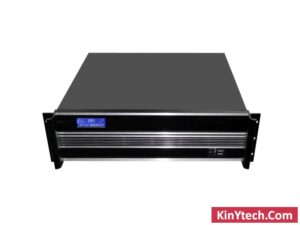
A server chassis is a metal structure that houses or physically assembles servers in a variety of configurations. A server chassis allows several servers and other storage and ancillary devices to be housed in a single physical body. A server chassis is often referred to as a server case or a server casing.
It is typically utilized in situations where numerous parallel servers must operate on a critical business application. They are not usually designed to be connected to a display device, although they can be connected to a laptop/monitor for application and OS installation and maintenance.
Server chassis exist in a variety of shapes and sizes, including rack and pedestal models. They are divided into three categories based on their physical dimensions: 1U, 2U, and up to 20U and beyond, where U denotes the number of units. In a rack or tower form/enclosure, a 1U server can typically accommodate up to two servers.
A server case can be readily upgraded/expanded to accommodate more servers, such as from 1U to 2U and beyond.
Rackmount V. Tower, Which Server case should you choose?
As users, you often might be confused about the server cases you choose as your first or new purchase. While the options are simple— just two, making the decision can be extremely tough. Hence, to ease the problem and mitigate the trouble of being in two minds, here are the detailed pros of both types.

Rackmount-
The rack server resembles a switch. There are 1U racks, 2U racks, 4U racks, and so forth.
Benefits
- Simple to Operate
In most cases, server rooms are located in a central location with centralized management. When there are a lot of tower servers, management becomes highly inconvenient. The tangle of electricity lines and wires makes for a messy environment. On the other hand, Rack-mounted servers are in a cabinet. All the data lines are placed in the cabinet. The locked-up cabinets help to keep the inside clean, dustproof, and safe.
Tower Server
The most common server we find is the tower server. It has a similar appearance to our PC host, but it is more significant due to the numerous slots required to expand the server’s capabilities.
We can configure more features on the tower server because it has a larger chassis. It is for this reason that the tower server is suitable for a wide range of applications.
Benefits
- Simple to use
With so many slots, tower server chassis frequently leave a lot of room for redundancy of hard drives, power supply, and other components. This server doesn’t require any additional hardware, takes up little space on demand, and scales well.
- Cost-effective
Because of its inexpensive cost, this server is particularly well suited to popular entry-level and workgroup server applications. Most SME users will be satisfied with their performance. It is still widely used in the market.
If you are searching for a new case and are confused about whether you should opt for a PC Rackmount case or a tower case, do your effective research before settling on a good choice.
The following process would be to find an excellent seller to purchase a good item. If you are tired of searching for a good seller, then check out the services of Kiny Tech. The online e-commerce site has a wide variety of products known for their resilience and affordable prices. To learn more, visit their website at https://www.kinytech.com/.

